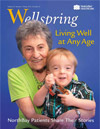A Second Opinion Leads to Second Chance at Life
 Antoinette Montojo is happy to be back at work following a cancer diagnosis
Antoinette Montojo is happy to be back at work following a cancer diagnosis
Life was hanging in the balance just over a year ago for Antoinette Montojo. At summer’s start she was an active, tennis-playing, working mother of three. By Labor Day, she was so sick she was nearly on her death bed.
Looking back, she can’t believe how close she came. “It started with pain in my back,” recalls the 54-year-old Fairfield resident. “At first I thought it was just the kind of pain that comes from getting older. But then it became more.”
You need someone with you during this time. It would be hard to do it on your own.
—Antoinette Montojo
She was not eating well, became nauseous, started losing weight and getting bad headaches. Within two short months, she says, “I was really in a bad state.”
Her primary care physician, Padma Dasari, M.D., ordered a CT scan and a biopsy, and the results indicated cancer. Getting the news “was a big blow,” Antoinette says.
But, exactly what kind of cancer? While a pathologist in Sacramento offered a diagnosis of sarcoma, a kind of cancer that affects either bone, cartilage, fat, muscle or blood vessels, Antoinette’s oncologist, James Long, M.D., of the NorthBay Cancer Center, believed it was something else.
“He thought it was lymphoma (cancer of the lymphatic system), and got a second opinion from doctors at Stanford,” she explains.
“It took three weeks to get a definitive answer,” Dr. Long recalls, and all the while Antoinette was getting sicker and sicker. When the second opinion came back as anaplastic t-cell lymphoma, a rare form of the disease, he started her on chemotherapy that night.
“It was a different kind of chemotherapy treatment than what I would have received with a sarcoma diagnosis,” Antoinette says.
She believes Dr. Long’s depth of experience as a hematologist and familiarity with lymphomas saved her life.
“I am so glad he went by his knowledge of lymphoma and didn’t go with the other diagnosis,” she says. “I got a second chance at life.”
“We are making good headway in general on treating lymphomas,” Dr. Long says, “because we’re developing targeted therapies that have less toxic effects and higher efficacies. We’re getting better at it all the time. She has a good prognosis now and her kind of lymphoma has a 80 percent cure rate.”
That makes Antoinette one of more than 628,000 Americans who are living with lymphoma, according to the Leukemia & Lymphoma Society. She’s not only living, but thriving, she adds.
Since completing her chemotherapy treatments, she has been able to heal, gain strength, and even returned to her job in Patient Financial Services at NorthBay Healthcare.
Throughout her healing journey, she was able to lean on her husband and adult-age children for help. “You need someone with you during this time,” she says. “It would be hard to do it on your own.”
Her advice: don’t be afraid to ask for help, because you will need it. “It takes a little humility. We, as women, are used to taking care of others. But you will need the help.
“Dr. Long told me I was close to dying,” she recalls. “I thought it was all a bad dream. Now, I have a new outlook on life.” She lets things that used to annoy her go by the wayside, and spending time with her family is a priority now. “Nothing else matters but my family, and my faith,” she says.
